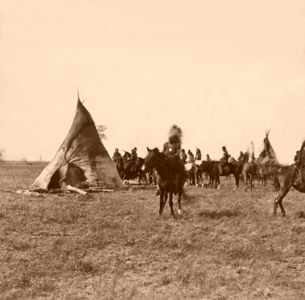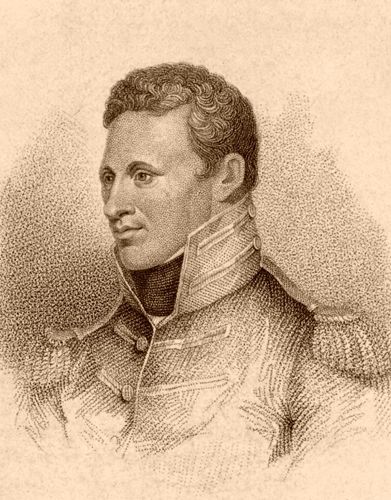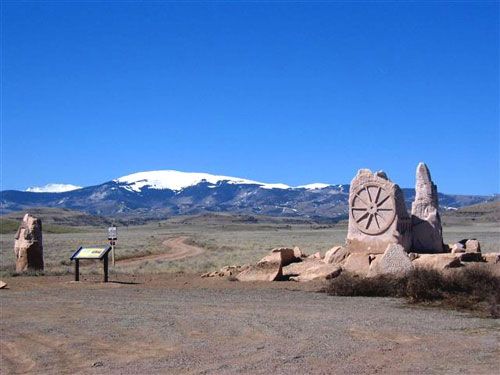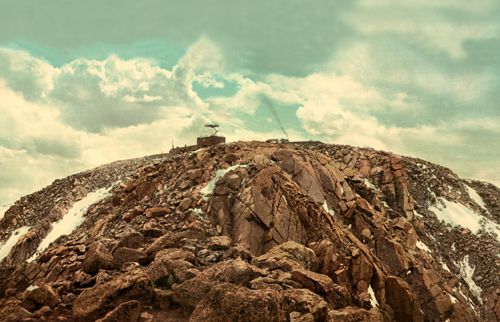“Nothing that Zebulon Montgomery Pike ever tried to do was easy, and most of his luck was bad.” Thus, Donald Jackson began his forward to the annotated edition of Pike’s journals and letters in 1966. A pathfinder who got lost, Pike could have been as revered as Lewis and Clark but instead remains an indistinct historical figure.
Born in New Jersey in 1779, Pike joined the U.S. Army at the age of 20, following in the footsteps of his father, also named Zebulon, who was a veteran of the American Revolution. Lieutenant Pike’s early duties along the Ohio frontier consisted of service as a regimental paymaster. Pike lamented his lack of formal education, carrying books into the wilderness and reading voluminously. A slim, blue-eyed, pompous young man with an odd habit of tilting his head to one side, Pike was highly ambitious and efficient.
Pike soon became the protégé of James Wilkinson, the commanding general of the U.S. Army. Wilkinson, one of history’s worst scoundrels, was also secretly a double agent for Spain. In the summer of 1805, Wilkinson gave Pike the difficult assignment of surveying the upper Mississippi River. While Lewis and Clark were at the headwaters of the Missouri River far to the West, Pike left St. Louis, Missouri, with orders to explore the Mississippi, purchase sites from American Indians for future military posts, and bring a few important chiefs back to St. Louis for talks. He took a force of 20 men on a 70-foot keelboat up the Mississippi River, departing from Fort Bellefontaine on August 9, 1805. Pike and his men explored the river into modern-day Minnesota, traveling to Cass Lake, which they identified (incorrectly) as the river’s source. The expedition returned to St. Louis on April 30, 1806. Pike was only modestly successful in his relations with the Indians but brought back important geographical information about a little-known portion of the new Louisiana Territory.

Pawnee Camp in Nebraska by John Carbutt, 1866.
Pike’s second expedition, 1806-1807, was designed to accomplish several goals, including providing an escort for some Osage Indian travelers from St. Louis back to their villages, negotiating peace between the Kanza and Pawnee tribes, and attempting to make contact with the Comanche people on the high plains. Pike was also to explore the headwaters of the Arkansas River, then proceed south, locate the source of the Red River, and descend it to the Mississippi. Most importantly, Pike was to ascertain what the Spanish were doing along the poorly defined southwestern border of the Louisiana Purchase. Pike brought along nearly all the soldiers from his Mississippi River expedition, men he called a “Dam’d set of Rascals,” but who, nonetheless, retained the confidence of their commander. General Wilkinson’s son, Lieutenant James Biddle Wilkinson, was to go part of the way and lead a small detachment back to St. Louis via the Arkansas and Mississippi Rivers. General James Wilkinson launched Pike’s expedition without the authorization of President Thomas Jefferson or the War Department, although it was approved retroactively. Tensions with Spain were high, and many Americans expected a war.
During this period, Wilkinson, Governor of Louisiana, was ordered to engage in intelligence operations against Spain, using army officers disguised as traders if necessary. What Wilkinson was really up to, however, has remained a mystery. In collaboration with Aaron Burr, it appears that he was planning a coup in the West. Whether this was a traitorous movement designed to separate the western territories from the Union or a plot to conquer Spanish territory without officially involving the United States Government has never been determined. At any rate, Pike’s expedition to the Spanish borderlands would serve the official and unofficial needs of James Wilkinson. Pike almost certainly knew nothing of the Wilkinson/Burr intrigues but knew his service as a spy for his country was important. A letter between Pike and Wilkinson, written on July 22, 1806, leaves little doubt that Pike was to scout as close as possible to Santa Fe, New Mexico, allowing for the possibility that Spanish authorities might capture him. If discovered, he would use the cover story that he had become lost while en route to Natchitoches, Louisiana.
Zebulon Pike set out on July 15, 1806, with an assortment of 18 enlisted men from the First Infantry Regiment; his second-in-command, Lieutenant Wilkinson; a volunteer physician, Dr. John H. Robinson; and Baronet Vasquez, an interpreter from St. Louis. The group made their way across Missouri, returning the Osage people to their villages (in the area of today’s Lake of the Ozarks) and moving out diagonally across Kansas. Pike talked a band of Pawnee into hauling down the Spanish flag, which flew above their village, and replacing it with the Stars and Stripes, even though a troop of Spanish cavalry 300 strong had recently visited.
Upon reaching the Arkansas River, Lieutenant Wilkinson left the party with five men, returning successfully to St. Louis despite three desertions. Pike and the 15 others started up the Arkansas River on October 28, following the trail of a troop of Spanish cavalry. On November 11, Pike made a bold decision; even though his party did not have the clothing, equipment, or supplies for a winter expedition, they would press on.
Proceeding nearly due west, they reached the site of modern-day Pueblo, Colorado, on November 23. Fascinated with a blue peak in the Rocky Mountains to the west, Pike explored it with two soldiers and Dr. Robinson, leaving the bulk of the men at a base camp. Pike spent several days trying to reach the peak (which would later bear his name), but the lack of winter clothing and food eventually drove him back to the base camp. Zebulon Pike never set foot on Pike’s Peak.
The Arkansas River split in the mountains, and Pike noted since the “geography of the country had turned out to be so different from our expectation, we were somewhat at a loss which course to pursue unless we attempted to cross the sno cap’d mountains…” Pike decided to follow the trail of the Spanish cavalry and head up the north fork of the Arkansas River, called Four-Mile Creek. This branch soon dwindled, as did the Spanish trail, so Pike turned overland due northward, discovering a river on December 12, which he correctly determined was the south fork of the South Platte. Crossing a mountain pass, he came to another river he thought was the Red. The expedition was back on the Arkansas River, 70 miles upstream from where they had left it two weeks earlier. Snow began to deepen, and Pike was disappointed that he could not reach the river’s source. The men spent Christmas eating buffalo meat near the modern-day city of Salida, Colorado. They worked their way down the river, the ice solid enough to support their horses, the massive vertical walls of the Royal Gorge towering above them on both sides. They were soon frustrated to find they had traveled in a big circle. The mountains must be crossed on foot to reach the Red River.
The interpreter Vasquez and Private Patrick Smith were detailed to stay with the horses in a small wooden stockade, while Pike set out with the others to find the Red River on January 14, 1807, through a howling blizzard in Wet Mountain Valley. Nine 14 men, including Pike’s best hunters, soon suffered from frostbitten feet. Pressing on, wading through sometimes waist-deep snow, Pike left three men behind who could not continue. Crossing the Sangre de Cristo Mountains, Pike found the area of the present-day Great Sand Dunes National Monument and the headwaters of the Rio Grande, which he mistakenly thought was the Red River. A small stockade was built near modern-day Alamosa, Colorado.
Dr. Robinson begged leave to contact the Spanish officials in Santa Fe, as he had a document that gave him authority to collect debt for a merchant in Kaskaskia, Illinois. Pike gave his permission, and Robinson hiked overland to reach his objective, telling Spanish Governor Alencaster on his arrival that he had recently left a party of hunters. Suspicious, Alencaster reported the incident to his superiors and sent out patrols, hoping to apprehend some of the doctor’s companions.
In the meantime, Pike sent back two relief parties to bring up the horses and his three scattered men with frostbite. Only one of these men returned; the others, too sick to move, sent bits of gangrenous toe bones to Pike in a macabre appeal not to be abandoned. On February 26, 1807, a troop of Spanish soldiers rode up to Pike’s stockade and informed him that he was in Spanish territory. “I immediately ordered my flag to be taken down and rolled up,” Pike wrote. The Spanish patrol rounded up the frostbitten stragglers, escorting the entire party to Santa Fe. Pike’s papers were confiscated, and he was sent south to Chihuahua. Neither Pike nor his men were mistreated; the majority were returned to U.S. territory at Natchitoches, Louisiana, on June 30, 1807. Dr. Robinson claimed asylum in Mexico but was not allowed to stay. Five of the men were held by the Spanish for two years, and one, Sergeant William Meek, after killing Private Theodore Miller in a drunken scuffle, was imprisoned until 1821. The Spanish governor was reprimanded by his king for releasing Pike before receiving an apology from the U.S. Government for trespassing.
Zebulon Pike was suspected of having a role in the “Burr Conspiracy” upon his return to the United States; although untrue, this tainted his career for some time. Pike was not received with a glowing welcome by President Thomas Jefferson. He considered him a competent military man but not an explorer/scientist on the level of Lewis and Clark. Neither Pike nor his men received extra pay or grants of land for their service.
Pike’s chance for personal glory came when war was declared on Great Britain in 1812. While leading a successful attack on York, the capital of Upper Canada (today’s Toronto), on April 27, 1813, Brigadier General Pike was fatally wounded by flying debris when a powder magazine exploded. Throughout an amazing life, this stubborn and persistent man performed extraordinary feats on behalf of his country, but luck was never with him. Unlike his rivals, Lewis and Clark, he is little remembered today, save for using his name on a mountain he never climbed.
Compiled & edited by Kathy Alexander/Legends of America, updated September 2023.



